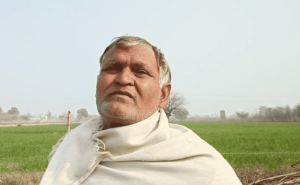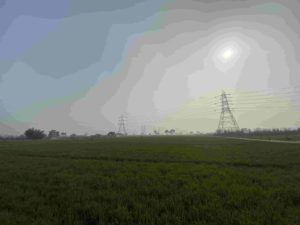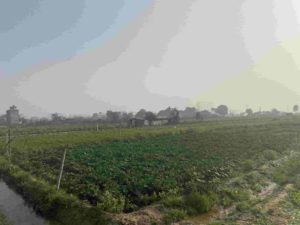Hindon river, a tributary of Yamuna, is not only a health hazard for the rural population living by the river but also the urban population of Delhi-NCR consuming vegetables, pulses, grains produced from the toxic water of this river
In villages alongside Hindon and its tributaries, water from the highly polluted river is used for irrigation.“Farmers whose farmland is close to the river bank use it but not all farmers. In my village, farmers use groundwater through submersibles,” says Ramkumar, a farmer from Ataur village in Ghaziabad.

Ramkumar believes that the polluted water of Hindon with industrial effluents improves crop productivity. “Since water is contaminated with various chemicals, it is in fact more helpful in farming,” he says with unscientific conviction.
“We sell our produce not only in Ghaziabad but in Delhi’s Azadpur mandi, Ghazipur mandi, wherever we get good prices” he adds. Vegetables like carrot, cauliflower, peas are grown from highly toxic water of this river and have become an integral part of Delhi-NCR’s food chain. That means Delhi, not only breathes polluted air but also eats polluted food.
In 2015, the National Green Tribunal banned the cultivation of vegetables on the Yamuna floodplain, due to toxicity of water infecting vegetables and fruits. But this practice is going on unabated on Yamuna’s floodplain, more so by the Hindon, and its tributaries Krishni and Kali river, and reaching the plates of Lutyens Delhi.
As per a study conducted by the National Environmental Engineering Research Institute (NEERI), vegetables that are sold in Delhi-NCR contain high amounts of toxic elements like lead. The safe level is set by Food Safety and Standards Authority of India (FSSAI) at 2.5 mg/kg. While vegetables grown on the Yamuna floodplain have been found to have led content between 2.8 mg/kg to 13.8 mg/kg.
Vikrant Tongad, an environmentalist, told Patriot, “Farmers feel that the water of Hindon is helpful in farming because it has more phosphate content, that works as a fertiliser — but it is toxic.” Farmers don’t have any option. The water of Hindon is polluting the groundwater and becoming integral to our food chain.

A dead river
Hindon river, Najafgarh drain and some other small drains account for 76% of the pollution that Yamuna carries. Later the Yamuna meets Ganga, transferring the pollutants that merely 2% of Yamuna’s stretch in the capital city is exposed to. Therefore, the Hindon river is somewhat linked to the cleaning of the river Ganga and Yamuna.
Hindon originates from Saharanpur district in the lower Himalayas. Hindon and its tributaries (Kali and Krishni rivers) flow almost 300 km through six districts of western Uttar Pradesh before merging with the Yamuna just outside Delhi.
The river has got the status of “dead river” owing to almost zero aquatic life. But the water from the river is used for various purposes in 148 villages situated by this river and its tributaries. This has created health hazards for residents of these villages. The water-borne ailments that include limb deformities to cancer have put an estimated 50 lakh people from these villages at risk.
Various studies including the UP Pollution Control Board’s own assessment found that water pollution in Hindon river is higher than the prescribed limit by the National Pollution Control Agency, i.e. CPCB. A study published in October last year collected samples from six different sites and analysed pH, turbidity, electrical conductivity (EC), total dissolved solids (TDS), total alkalinity (TA), total hardness (TH) and calcium hardness (Ca-H), chemical oxygen (COD) demand, biochemical oxygen demand (BOD), dissolved oxygen (D.O.), sulphate (as SO(4)(2-)), nitrate (as NO(3)(-)) and chloride (Cl-) levels and much higher variation on each matrix. The BOD and COD were found (27-51 mg l(-1)), (85.0-337.4 mg l(-1)) respectively.
Therefore, the condition of the river and its impact on the lives of people has been in media glare for the last few years, as people living by this river are facing various health issues. The matter is being heard by courts. The Doaba Paryavaran Samiti, an NGO that works for the environment, has filed a case regarding this with the National Green Tribunal (NGT).
NGT took cognisance of its health impact and passed various orders since 2017, for which various government agencies are yet to comply with completely. It ordered the Uttar Pradesh government to provide safe drinking water to these villages with immediate effect, out of which as per compliance report submitted by UP government work on supplying piped water has been completed in 103 villages out of 148.
NGT also in its order asked to organise health camps and to prepare a micro plan finding the cause of these diseases in the concerned regions but so far no progress has been made.
“The condition of Hindon is still worse, no aquatic life. But government agencies are doing nothing. There is no dearth of funds either,” says Tongad. Tongad also informed us that he filed an RTI to know how many people have been jailed for violating the river and how many industries have been sealed so far. “But no satisfactory response was received.”
Villages by this river are growing fast. In Ataur, apart from big farmlands growing vegetables and food grains, RCC roads, big vehicles and big houses, tells that this village has developed very much in the last few years. Ramkumar told us that, in the last few years, a lot of houses were built, some even encroaching on the drainage area of the river.
Environmentalists say that the Hindon floodplain is being violated by builders, as its floodplain is the most attractive destination for people buying homes. Therefore, housing societies are cashing onto it, ignoring the environmental damage it may cause. Tongad gave an example of Gaur city, saying it is an example of illegal construction on Hindon’s floodplain.

The issue of illegal construction on floodplains is more than a decade old. But no satisfactory progress has been made. Floodplains of a river work as a natural filter and help clean the river; illegal construction encroaching on the floodplain are eliminating this option, thereby allowing the river to be polluted but also contaminating of groundwater in the region.
On 13 June 2019, a team comprising committee officials, along with the UP Pollution Control Board (UPPCB) staff and officials from the Noida and Greater Noida authorities, inspected the Hindon to check the status of pollution. They were upset about its condition. In June 2019, Chief Minister Yogi Adityanath also showed concern and directed officials to stop illegal construction.
Manu Bhatnagar, the principal Director of Indian National Trust for Art and Cultural Heritage (INTACH) says, “Government has clear instructions from the court that it should demarcate the 100-year floodplain. That means an area which is inundated by massive floods once in a hundred-year period.”
Showing disappointment over illegal construction on Hindon floodplain, Bhatnagar says “Our regulations are weak and our enforcement is even weaker.”
Cleaning the river
So far, every effort to clean Hindon seems to have failed. INTACH in 2017 prepared a restoration plan after studying the river, which it had submitted to the UP government.
Bhatnagar, who also directed this project, says, “The talk about pollution is a distraction. The pollution is in Ghaziabad. The real problem is, there is no flow in the river.”
Aspects like adequate minimum flow, riverine biodiversity, riparian areas and floodplains, cultural and livelihood aspects are often ignored.
“To understand what is required to restore the river is to study Hindon basin and that is what we did in our report and suggested measures,” he adds.





